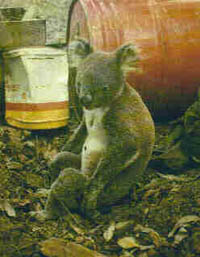Also see Health Effects and Signs & Symptoms of Lindane Exposure.
EPA: Restricted Use Products (RUP) Report July 2000
Lindane is used on all kinds of animals, many products containing lindane listed in the right column, are made for specific animals such as cats, dogs, horses, mules, hogs, sheep and cattle.

Cancer Hazard * Lindane may be a CARCINOGEN in humans since it has been shown to cause liver, lung, endocrine glands and other types of cancer in animals.
Animal symptoms that have been observed are increased respiration, restlessness accompanied by frequency of micturition, intermittent muscular spasms of the whole body, salivation, grinding of the teeth and consequent bleeding from the mouth, backward movement with loss of balance and somersaulting, retraction of the head, convulsions, gasping and biting, collapse and death usually within a day. (PUBMED)
Carcinogenicity:
Lindane – ACGIH: A3 – Animal Carcinogen
California: carcinogen – initial date 10/1/87 NTP: Suspect carcinogen
OSHA: Possible Select carcinogen
IARC: Group 2B carcinogen (listed as ** undefined **).
Epidemiology:
Experimental reproductive, and teratogenic effects have been reported. Contains an ingredient on IARC as animal sufficient evidence. It contains an ingredient which may cause cancer based on animal data.
Reproductive effects have occurred in humans.
Reproductive effects have occurred in experimental animals.
(MSDS)
Lindane Report
LAST WEEK the Pesticides Safety Directorate based in York reviewed the effects of the ‘active ingredient’ chemical Lindane.
For almost 13 years Angela Brocklehurst, Westie breeder, has expressed concern over the harmful effects of the chemical when it was used as an insecticide in a vapouriser lamp. Her fears were heightened by the mortality and abnormality rates in successive litters of Westie puppies. She also drew parallels when reports of the suspected use of Lindane as a wood preservative caused problems for a midlands’ mother. Her investigations and knowledge have led her to provide information to MAFF and the European Commission Co-ordination Review System. Next week Lindane is to be discussed at the Mammalian Toxicology meeting and in May the Fate and Behaviour meeting.
See next week’s issue for the breeder’s own story, exclusive to OUR DOGS.
http://www.dogsworldwide.com/news/apr23-99.htm#Lindane
Seizures in Dogs following lindane treatment.
Recognition and Management of Pesticide Poisonings
The following have been reported to cause serious illness or death when used ON dogs:
- Carbaryl (Sevin)
- Chlorpyrifos (Dursban)
- Dichlorvos (DDVP, Vapona)
- Fenthion (Prospot)
- Lindane
- Malathion
- Phosmet (Prolate, Kemolate)
- Permethrin
- Pyrethrins (but not microencapsulated)
- Ronnel (Korlan)
- Tetrachlorvinphos (Rabon)
Health Effects of Solvents
Animal studies in the toxicology literature emphasize the role of solvents as neuro-toxins.13 Solvents that act primarily on the central nervous system ó including toluene, xylene, and styrene ó have been demonstrated in many animals to cause morphological and biochemical changes in the brain that, in turn, produce neuropsychological, motor, and behavioral effects. Solvents that act as peripheral nervous system toxins have been shown in animals to damage axons, myelin, and the function of axonal transport.
http://www.cehn.org/cehn/trainingmanual/manual-solvents.html
Stockpest
DIRECTIONS AND LIMITATIONS FOR USE (STOCKPEST SOLUTION)
Mix 40 mL of STOCKPEST concentrate with 9 L of water. Apply to animal with a pump sprayer or with a cloth or brush. Be sure to treat base of tail, inside of flanks, legs and underside of neck. All animals should be sprayed before stabling or being put out to pastured. Do not use on sick and emaciated animals. DO NOT use on dairy animals or in milk room. DO NOT use on meat animals within 30 days of slaughter.
INDICATIONS AND DOSAGE
Beef: For lice and ticks, apply as an overall spray using 1.2 to 2.3 L of STOCKPEST solution per animal. For lice, repeat in 14 to 18 days. DO NOT use on calves under three months of age.
Swine: For lice, fleas and mange, apply as an overall spray using 1.2 to 2.3 L of STOCKPEST solutionper animal. For lice, repeat in 14 to 18 days. Pay particular attention to sanitization of farrowing pens/barns in order to avoid infestation of piglets. It is not recommended to treat sows within 2 weeks of farrowing.
Sheep and horses: For lice and fleas, apply as an overall spray using 2.4 to 4.5 L of STOCKPEST solution per animal. For lice, repeat in 14 to 18 days. DO NOT use on colts under three months of age.
PRECAUTIONS: KEEP OUT OF REACH OF CHILDREN . Avoid inhalation. Wash thoroughly after handling or using and before eating and smoking. Wash contaminated clothing before reuse. Do not contaminate ponds, lakes or streams. Lindane is toxic to fish, birds and other wildlife. Avoid treating areas inhabited by wildlife.
DISPOSAL:
- Rinse the emptied container thoroughly and add the rinsings to the spray mixture in the tank.
- Follow provincial instructions for any required additional cleaning of the container prior to its disposal.
- Make the empty container unsuitable for further use.
- Dispose of the container in accordance with provincial requirements.
- For information on the disposal of unused, unwanted product and the cleanup of spills, contact the Provincial Regulatory Agency or the manufacturer.
FIRST AID: This product contains petroleum distillate. If swallowed, DO NOT induce vomiting. Obtain medical attention immediately. In case of skin contact, wash with soap and water. In case of eye contact, rinse with water and get prompt medical attention.
TOXICOLOGY: Lindane is an organochlorine insecticide. Poisonous if swallowed, inhaled or absorbed through the skin.
SYMPTOMS OF POISONING: Nausea, vomiting, hyper-irritation, convulsions and/or coma, and other symptoms typical of organochlorinated insecticide poisoning. Barbiturates may be given to control convulsions. Oxygen may be indicated. Keep patient quiet. Avoid use of morphine and adrenaline.
NOTICE TO USER: This control product is to be used only in accordance with the directions on this label. It is an offense under the Pest Control Products Act to use a control product under unsafe conditions.
DISPAR, DIVISION OF VETOQUINOL N.-A. INC.
LAVALTRIE, CANADA J0K 1HO 950479